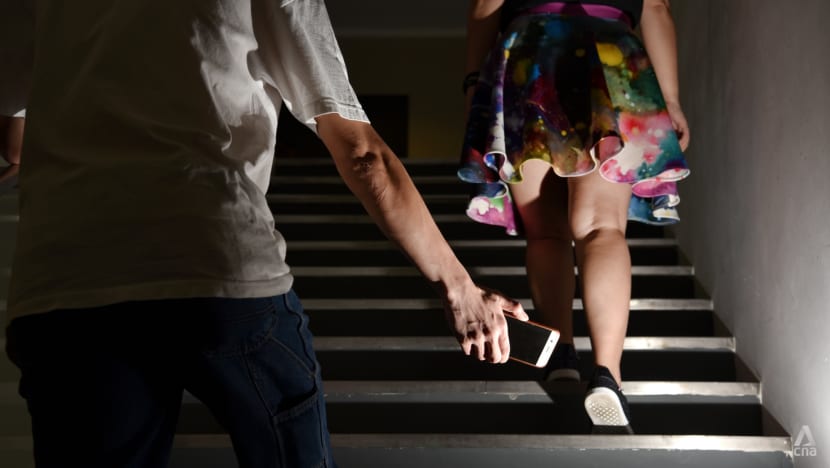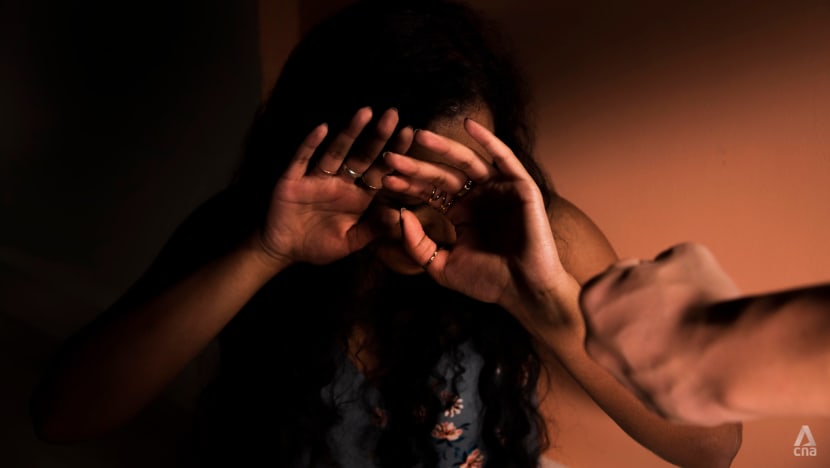commentary Commentary
Commentary: She’s practically asking for it? Do Singaporeans subscribe to rape myths?
Surrounded by rape myths that undermine the seriousness of sexual assault, some survivors may hesitate to call their experiences sexual assault, discuss it with others, or seek assistance, says AWARE’s Shailey Hingorani.

Photo illustration of a man taking upskirt photos. (Photo: Jeremy Long)
SINGAPORE: Victim-blaming comments — i.e. comments that put the onus of avoiding sexual assault on the victim — are unfortunately commonplace in our society.
It’s no surprise, therefore, that they’ve reared their ugly head in recent days - when news broke about the rape of 15-year old girl after a game of Truth or Dare, and the 13 Telegram groups circulating explicit images without the knowledge of the people pictured.
READ: Leaked sex tapes and child porn: A look into 13 illicit Telegram chat groups
READ: 4 people arrested over 'SG Nasi Lemak' Telegram chat group
Garbed as well-meaning concern and advice, the comments nevertheless perpetuate deeply harmful rape myths.
TOXIC SOCIAL MEDIA CHATTER
Three issues have featured prominently in many of the online comments about the teenage rape case: The girl’s intoxication, her choice of company in a gang of boys, and her lack of parental supervision. They all place at least partial blame of her rape on her, and her parents when they did not impose strict curfews on their daughter’s movements.
Separately, in CNA’s story about the Telegram groups, a victim referred to as Dania is quoted as saying that in her experience, women who have revealing photos taken are shamed as being improper, and responsible for their own predicament when those photos (inevitably, it is assumed) get circulated publicly.
READ: Commentary: The ubiquity of cameras and social media fuels unhealthy mob behaviours
The following statements might be obvious, but are worth repeating:
Drinking alcohol is not equivalent to consenting to sex. Spending time with boys is not equivalent to consenting to sex. Leaving your child unsupervised for a night is not equivalent to consenting to her having sex.
Taking a revealing photo intended for private use is not equivalent to consenting to have it circulated to thousands of strangers.

When the majority of comments on these news stories discuss what the victims did wrong, instead of what the perpetrators did wrong, you might be tempted to dismiss that as idle social media chatter.
But these comments speak to underlying rape myths we continue to hold about sexual violence, alcohol consumption, the company of men and women’s behaviour as a society.
RAPE MYTHS
Rape myths are beliefs about rape that serve to deny, downplay or justify sexual violence.
They help people ignore the complexity of rape in its full context — for example, the understanding that abusive relationships can feature genuine love alongside manipulation and victimisation.
Rape myths determine which incidents of assault are taken seriously and considered more “real” than others.
Rape myths can take one or a combination of four forms. They can blame the victim (e.g. “she should have resisted the attacker more”), cast doubt on allegations (e.g. “she just regrets having sex with him and is now looking for a way to feel better”), excuse the accused’s behaviour (e.g. “he was too drunk to know what he was doing”), or insist that sexual violence only happens to specific types of women (e.g. “slutty girls get raped and good girls don’t”).
For example, we see the first and fourth types in the case of the teenage rape. Online commenters rushed to declare that a girl who is the “type that drinks”, responds to sexual questions from boys when playing Truth or Dare, and stays out at night is practically asking to be raped.
READ: Commentary: All this anger over voyeurism but what we need is respect
Rape myths enjoy a high level of acceptance in Singapore. About 45 per cent of over 1,000 respondents to an IPSOS survey agreed with this statement: “Women who wear revealing clothes should not complain if men make comments about their appearance.”

Would those respondents also agree that “women who wear revealing clothes should not complain if men take non-consensual upskirt photos of them and share them in Telegram groups”? It doesn’t seem like that much of a stretch. The sheer size of those 13 Telegram groups points to how normalised an opinion that may be.
WE HAVE TO CHALLENGE RAPE MYTHS
Rape myths are pernicious for three reasons.
First, they discourage help-seeking behaviour. By undermining women’s experiences — for example, by asking questions that focus on the victim’s behaviour, mannerisms — they create a sense of violation that revictimises survivors.
They can spin survivors into a cycle of self-doubt (“Did my clothing communicate consent to sexual activity? Should I not talk to men in bars?”), which makes them feel too ashamed or too guilty to share their experiences with friends and family.
Even as many survivors try to consciously reject rape myths, they may find it difficult to escape the socially ingrained feeling they should have done something differently or that they are somehow at fault. Many end up isolated and do not get the support they need to help recover from the trauma of the rape.
READ: Commentary: Here’s what zero tolerance towards sexual misconduct looks like
READ: Commentary: Terms like ‘lucky boy’ and ‘men will be men’ are problematic double standards
Second, for the same reasons as above, rape myths discourage reporting. AWARE’s Sexual Assault Care Centre finds that seven out of 10 of its clients do not report their experiences to the police. This means that most perpetrators are never brought to justice, and live out their lives without any consequences for their violent actions.
Third, rape myths are used to create cautionary tales, mostly aimed at women, outlining behaviour that is appropriate. Women are routinely advised to monitor their alcohol intake when they go out, never leave their drinks unattended, or only spend time with men when other women are present.
At an event AWARE hosted on so-called “revenge porn” in 2018, a couple of well-meaning parents suggested the best way for young women to protect themselves from seeing their doctored photos on pornographic websites was to withdraw entirely from social media.

Whether or not these measures strike you as realistic (is it reasonable to expect women to be able to withdraw from online spaces in this day and age?), you may find the act of advising them to be harmless.
But there is harm in prescribing these “safety tips” to women. The harm lies in the implication that if you fail to take any of these steps, you have somehow caused yourself to be assaulted, and should be held responsible for this failure, whereas the full responsibility for assault should lie upon the assaulter’s shoulders.
WHAT WILL HELP
Traditional gender norms — e.g. that men are always the initiators of sex, that women must offer token “resistance” to sex to be considered lady-like, that sex is some kind of conquest and women sexualised objects to conquer — inform rape myths.
Sex education in schools often reinforces these traditional gender norms, and, by focusing on abstinence only, does not adequately prepare students to deal with intimate relationships.
Although gender equality education has long been suggested as a key component to violence prevention strategies, it does not feature prominently in most school curricula.
READ: Commentary: University campuses must be safe places for all
READ: Commentary: The tightrope universities walk in tackling orientation activities like the 'kukubird' controversy
Irresponsible media also, reinforces these gender norms through the hyper-sexualisation and sexual objectification of women, which leads to greater acceptance of violence against women and victim-blaming.
We need a two-pronged strategy to promote gender equality that will help address violence against women. First, we must introduce comprehensive sex education in schools, and in-person mandatory anti-harassment trainings in colleges. These should cover gender roles and consent, and deconstruct rape myths.

Second, we need media-based interventions. Apart from public awareness campaigns that challenge traditional gender norms, we need new media guidelines that discourage the use of gender stereotypes and hypersexualised female bodies.
We could learn from the Advertising Standards Authority of UK, which banned the depiction of men and women engaged in gender-stereotypical activities earlier this year. News outlets should adopt reporting guidelines on sexual violence to sensitively and ethically communicate sexual violence trauma.
It’s time we addressed these cultural attitudes, and promised survivors that we will indeed aim for zero tolerance of sexual violence.
Shailey Hingorani is Head of Research and Advocacy at AWARE.














